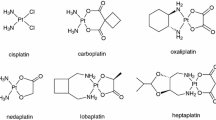Summary
Pre-clinical and clinical studies have shown that trifluoperazine (TFP) can modulate multidrug resistance. We have performed a Phase II trial of TFP and doxorubicin in doxorubicin-naive patients with metastatic breast cancer. We hypothesized that TFP would inhibit the development of doxorubicin resistance, resulting in an increased rate of complete response or a prolongation in response duration. Twenty patients with metastatic breast cancer were treated every 3 weeks with TFP 5 mg by mouth every 6 hours on days 0–5 and doxorubicin 60 mg/m2/96 hr on days 1–4 by continuous intravenous infusion. The first 5 patients were treated with TFP 15 mg by mouth every 6 hours, but the dose was reduced to 5 mg every 6 hours when grade 3–4 extrapyramidal toxicity was noted in 3 of the first 5 patients. Thereafter, neurologic toxicity was grade 0–2. No complete and 9 partial responses were produced in 20 patients (45%). The median response duration was 17 weeks (range 7–112). The combination of trifluoperazine and doxorubicin did not seem to produce a response rate or duration markedly different than that expected for doxorubicin alone in patients with metastatic breast cancer. Alternative trial designs may be necessary in future clinical trials investigating the inhibition of acquisition of drug resistance.
Similar content being viewed by others
References
Kessel D, Botteril V, Wodinski I: Uptake and retention of daunomycin by mouse leukemic cells as factors in drug response. Cancer Research 28:938–941, 1968
Shen DW, Fojo A, Chin JE, Roninson IB, Richert N, Pastan I, Gottesman MM: Human multidrug-resistant cell lines: increased mdrl expression can precede gene amplification. Science 232:643–645, 1986
Shen DW, Fojo A, Roninson IB, Chen JE, Soffir R, Pastan I, Gottesman MM: Multidrug resistance of DNA-mediated transformants is linked to transfer of the human mdrl gene. Molecular and Cellular Biology 6:4039–4045, 1986
Pommier Y, Kerrigan D, Schwartz RE, Swack JA, McCurdy A: Altered DNA topoisomerase II activity in Chinese Hamster cells resistant to topoisomerase II inhibitors. Cancer Research 46:3075–3081, 1986
Tsuruo T, Iida H, Tsukagoshi S, Sakurai Y: Overcoming of vincristine resistance in P388 leukemia in vivo and in vitro through enhanced by cytotoxicity of vincristine and vinblastine by verapamil. Cancer Research 41:1967–1972, 1981
Inaba M, Fujikura R, Tsukagoshi S, Sakurai Y: Restored in vitro sensitivity of adriamycin- and vincristine-resistant P388 leukemia with reserpine. Biochemical Pharmacology 30:2191–2194, 1981
Ganapathi R, Grabowski D: Enhancement of sensitivity to Adriamycin in resistant P388 leukemia by the calmodulin inhibitor trifluoperazine. Cancer Research 43:3696–3699, 1983
Tsuruo T, Iida H, Tsukagoski S, Sakurai Y: Increased accumulation of vincristine and Adriamycin in drug-resistant P388 tumor cells following incubation with calcium antagonists and calmodulin inhibitors. Cancer Research 42:4730–4733, 1982
Ozols RF, Cunnionb RE, Klecker RW, Hamilton TC, Ostechaga Y, Parrillo JE, Young RC: Verapamil and Adriamycin in the treatment of drug-resistant ovarian cancer patients. Journal of Clinical Oncology 5:641–647, 1987
Dalton WS, Grogan TM, Moltzer PS, Scheper RJ, Durie BCM, Taylor CW, Miller TP, Salmon SE: Drug-resistance in multiple myeloma and non-Hodgkin's lymphoma: detection of P-glycoprotein and potential circumvention by addition of verapamil to chemotherapy. Journal of Clinical Oncology 7:415–424, 1989
Miller RL, Bukowski RM, Budd GT, Purvis J, Weick JK, Shepard K, Midha KK, Ganapathi R: Clinical modulation of doxorubicin resistance by the calmodulin-inhibitor, trifluoperazine: a Phase I/II trial. Journal of Clinical Oncology 6:880–888, 1988
Andersson M, Daugaard S, von der Maase, Mouridsen HT: Doxorubicin versus mitomycin versus doxorubicin plus mitomycin in advanced breast cancer: a randomized study. Cancer Treatment Reports 70:1181–1186, 1986
Neidhart JA, Gochnour D, Roach R, Hoth D, Young D: A comparison of mitoxantrone and doxorubicin in breast cancer. Journal of Clinical Oncology 4:672–677, 1986
Henderson IC, Allegra JC, Woodcock T, Wolff S, Bryan S, Cartwright K, Dukart G, Henry D: Randomized clinical trial comparing mitoxantrone with doxorubicin in previously treated patients with metastatic breast cancer. Journal of Clinical Oncology 7:560–571, 1989
Cowan JD, Neidhart J, McClure S, Coltman CA, Gumbart C, Martino S, Hutchins LF, Stephens RL, Vaughan CB, Osborne CK: Randomized trial of doxorubicin, bisantrene, and mitoxantrone in advanced breast cancer: a Southwest Oncology Group study. Journal of Clinical Oncology 83:1077–1084, 1991
Author information
Authors and Affiliations
Rights and permissions
About this article
Cite this article
Budd, G.T., Bukowski, R.M., Lichtin, A. et al. Phase II trial of doxorubicin and trifluoperazine in metastatic breast cancer. Invest New Drugs 11, 75–79 (1993). https://doi.org/10.1007/BF00873916
Issue Date:
DOI: https://doi.org/10.1007/BF00873916




